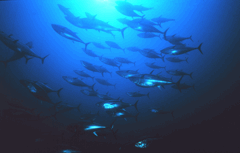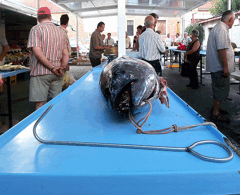Tanking Tuna
Air Date: Week of November 13, 2009

Bluefin tuna (Courtesy of NOAA)
Scientists estimate that Atlantic Bluefin populations have decreased by at least 90 percent over the last 50 years, and they warn that if over-fishing continues, the Bluefin species will be a distant memory. The international commission responsible for managing the Bluefin tuna population is meeting in Brazil to decide the fate of this iconic fish. Host Jeff Young visits Boston’s Sensing restaurant to hear about Executive Chef Brendon Bashford’s seafood choices. He then talks with Carl Safina, president of Blue Ocean Institute and adjunct professor at Stony Brook University. Professor Safina is skeptical that the commission will instate adequate protections for the Bluefin.
Transcript
YOUNG: From the Jennifer and Ted Stanley Studios in Somerville, Massachusetts - this is Living on Earth. I’m Jeff Young.
[KITCHEN NOISE; CLANGING METAL; SIZZLING SOUNDS]
YOUNG: On the menu today - sustainable fishing and decisions that could determine the fate of one of the world’s most valuable species of tuna. One big decision - from an international fishing commission. Other decisions – daily in kitchens just like this one.
BASHFORD: Jeff, I’m Brendan Bashford I’m executive chef here at Fairmont Battery Wharf in Boston.
YOUNG: Chef Bashford’s just about to inspect the daily shipment of fish.
[WHIRRING NOISE OF REFRIGERATOR]
BASHFORD: Here we are in our fridge now, Jeff. We’ve just received some beautiful scallops, some fresh live lobsters from Maine, and we also have some tuna.
YOUNG: What’s our tuna look like?
BASHFORD: Our tuna’s very fresh today. It’s Yellowfin, we get whole loins in – it looks nice and ripe.
YOUNG: Mind if I have a sniff?

Bluefin tuna in Supetar fish market (Croatia) (Polježičanin. Flickr Creative Commons.)
BASHFORD: No, go right ahead.
YOUNG: [sniffs] Ah, yeah. That’s a beautiful piece of fish, I’ve got to say. But, not Bluefin?
BASHFORD: No, no, not at all. We haven’t used Bluefin – Fairmont, as a company has mandated to us not to use Bluefin for at least a year and a half. So, this is Yellowfin tuna. Bluefin’s on the endangered species list, 97 percent of the fishery stocks of Bluefin tuna have been totally wiped off the earth.
[DOOR CLICKS SHUT]
YOUNG: Chef Bashford wants to educate cooks and customers about sustainable fish choices. Those who fish for the Atlantic Bluefin face tough choices too. The international commission responsible for managing tuna populations in the Atlantic is meeting in Brazil to decide on new catch quotas. But there’s considerable skepticism about whether that body will set adequate protections for the Bluefin. Carl Safina is one of those skeptics. He’s president and co-founder of Blue Ocean Institute and has written extensively about the decline of the Bluefin, a fish he has long admired.
SAFINA: It’s one of the most magnificent creatures in the world, and one of the most incredible fish in the sea, gets to be over 1,000 pounds; one of the very largest fish. It can cross the ocean and swim at highway speeds, it can keep the temperature of its blood about 20 degrees warmer than the surrounding water, so it’s a giant, warm-blooded fish that travels in big herds like buffalo did, except that these are predatory buffalo.

Bluefin tuna sushi (Bunbunlife. Flickr Creative Commons.)
YOUNG: And have you caught Bluefin tuna?
SAFINA: Yeah, I’ve caught them since I was about 12-years-old, but not in the last few years because we’ve demolished them. And bite-by-bite, we have eaten most of the ones that used to be in the ocean.
YOUNG: Tell me about catching a Bluefin. I’m guessing if you haul in a fish that can be longer than you are tall, that’s quite an experience.
SAFINA: Well, the first time I got hooked to a giant Bluefin I was sitting in a chair and I was harnessed to the reel, and had the rod, you know, between my legs, and when the line shot tight I simply got catapulted to my feet. The pressure on the rod was so enormous that my knees began to buckle and I started to go down to the deck. So, that’s the kind of overwhelming power that they are capable of generating.
YOUNG: Now, the Bluefin is really in two major populations, as I understand it. Tell me about where they go over the course of their lives, and what parts of the oceans are most important for the Atlantic Bluefin?
SAFINA: In the Atlantic, Bluefin tuna spawn in two places: in the Mediterranean Sea, and in the Gulf of Mexico. The fish then migrate out, so you have a pretty extensive set of migrations that get a little complicated to try to sort out, but the fish are declining in both populations. The population off the East coast of the US is actually doing much worse in terms of numbers, but the decline is not as bad anymore – it’s kind of stabilized. In the eastern part of the Atlantic, off of – you know, in the Mediterranean and off of Europe and off of West Africa, those fish are many more in number, but they are plummeting in number and declining much more rapidly.
YOUNG: How do we get to the point where a once common fish, just in the course of your lifetime, my lifetime, became something that is right down to, apparently, the bare minimum required for survival?

Bluefin tuna (Courtesy of NOAA)
SAFINA: Well, the ridiculous thing is that in the mid-1960s there was such alarm on the part of the people who were fishing for them at that time that they formed the first international fishery management agency in the world, this Atlantic Tuna Commission. By the mid-1970s, it was estimated that they had declined about 80 percent. Now, when people tell you how much they’ve declined, they say, oh they’ve declined about 80 percent since the mid-1970s, but by then they had already declined 80 percent. So, we probably have about one or two percent of the fish left. We’ve eaten about 99 percent of them.
YOUNG: So, are you at all hopeful that this meeting going on in Brazil might result in something that would place limits that would put us back in line with what scientists say we need to do to let the fish stocks come back?
SAFINA: You could knock me over with a feather if they do anything. The fishing management has done essentially nothing to put in place the quotas that their own scientists suggest.
YOUNG: So, what are the other options, then?
SAFINA: Listing the fish under the convention on international trade of endangered species, which would simply make it illegal to export the fish, regardless of anything the Tuna Commission says or does. That would cut off supplying the market in Japan with any fish that are not landed in Japan by Japanese fishermen. It would not end fishing for Bluefin in the Atlantic, but it would reduce the price so much that a lot of the fishing would ease. And it would actually do something for this fish, which I don’t expect the Tuna Commission to do. I certainly hope they do, but I will be shocked if they do anything significant. What is needed is an international moratorium and an international listing under CITES.
YOUNG: If we were to have those – a moratorium and the CITES listing – what do we know about how a fish like this might come back.
SAFINA: Fish are still breeding and their reproductive potential is absolutely enormous; they lay millions and millions of eggs. Those eggs hatch into very tiny larvae that suffer an incredible rate of natural mortality, but they do spawn classes of juvenile tuna which are noticed up the coast, and if we laid off of those fish and let them get big and let them start spawning, I think we really could allow the fish to recover, and I think they would.
YOUNG: Carl Safina with Blue Ocean Institute and author of “Song for the Blue Ocean.” Thanks for taking time for us.
SAFINA: Thank you so much for having me on.
Links
Atlantic Bluefin Tuna Fact Sheet 1
Living on Earth wants to hear from you!
Living on Earth
62 Calef Highway, Suite 212
Lee, NH 03861
Telephone: 617-287-4121
E-mail: comments@loe.org
Newsletter [Click here]
Donate to Living on Earth!
Living on Earth is an independent media program and relies entirely on contributions from listeners and institutions supporting public service. Please donate now to preserve an independent environmental voice.
NewsletterLiving on Earth offers a weekly delivery of the show's rundown to your mailbox. Sign up for our newsletter today!
 Sailors For The Sea: Be the change you want to sea.
Sailors For The Sea: Be the change you want to sea.
 The Grantham Foundation for the Protection of the Environment: Committed to protecting and improving the health of the global environment.
The Grantham Foundation for the Protection of the Environment: Committed to protecting and improving the health of the global environment.
 Contribute to Living on Earth and receive, as our gift to you, an archival print of one of Mark Seth Lender's extraordinary wildlife photographs. Follow the link to see Mark's current collection of photographs.
Contribute to Living on Earth and receive, as our gift to you, an archival print of one of Mark Seth Lender's extraordinary wildlife photographs. Follow the link to see Mark's current collection of photographs.
 Buy a signed copy of Mark Seth Lender's book Smeagull the Seagull & support Living on Earth
Buy a signed copy of Mark Seth Lender's book Smeagull the Seagull & support Living on Earth

